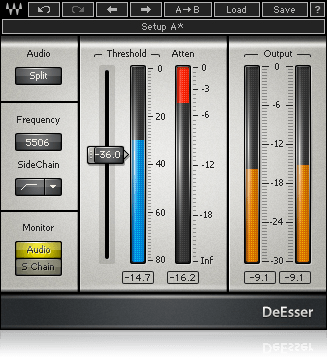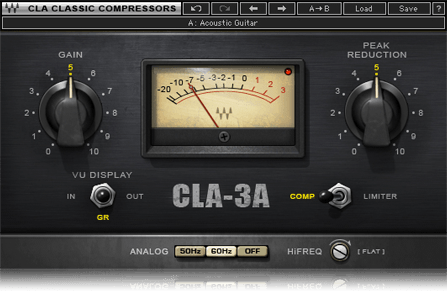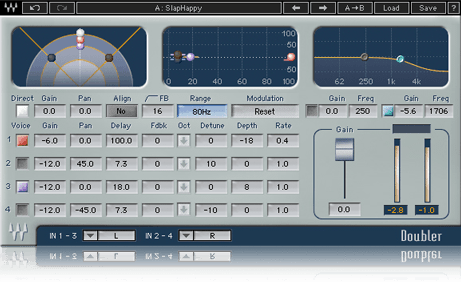He had some extra cash laying around and had noticed some “serious deals” on the Waves website. Of all the plugin companies out there, Waves has some of the longest history and offers a TON of plugins. Waves products are touted as “industry standard” and tend to run pricier than similar options from competing companies. Their style of marketing has created much interest and curiosity about their overall quality and usefulness; so my friend is certainly not the first to ask something like this about Waves, in particular. I could see why their value may be questioned. So, here is my current list of my favorite and most-used Waves plugins. In some cases, I have lumped two (or more) together, as they serve similar purposes, but in different scenarios. I’ll skip the stuff you can read on their web site and get right to my personal takes on these…

The Waves “DeEsser” (creative name guys…) is my go-to de-esser, and sometimes I use it creatively to compress background vocals. I mention this first, not because it is their best offering, but because it is normally the first one I use in a given session (almost always in 1st insert also). Compared to the stock Pro Tools de-esser, it causes way less distortion and is rather gentle at most settings. I like the band-split option that turns the de-esser into a simple 2-band compressor, with compression only affecting the treble band. Set the threshold low, with “multi” in, and listen to it remove almost all sibilance from a background vocal and effectively tucking it back in the mix…Viola! Sometimes the Waves DeEsser is TOO gentle, so when I am dealing with big-time “esses”, or crazy harshness, I’ll resort to using the C1 in side chain mode.

Now if you haven’t tried or heard of “side chaining” a compressor; you haven’t really lived! The idea is that you can have the compressor only react to a specific band of frequencies (or to another source, in other cases). When I use the C1 in side-chain mode, I can literally obliterate any pesky frequency peaks, such as strong “esses” caused by bad microphone choice or other phenomenon. I pretty much only use this guy when I really need to knock down some frequencies and the C4 won’t work, or requires too much setup. Long live the C1 (one of Wave’s very first offerings)- Classic! The only issue I have with this plugin in, is the lack of a MIX knob…
my alternative- stock “Digi” DeEsser (not nearly as good).

For the most part, I don’t think of Waves as having the best emulations of classic hardware, but here is one of a few exceptions- the VEQ-4 is pretty much my go-to EQ when creating a rough mix (and beyond). I like the sound, frequency choices, gain range, clean GUI, additional options and absolute ZERO latency in Pro Tools 10 and 11. I definitely prefer it over the 3-band version (VEQ-3) and think it operates smoother (and more intuitively) than Focusrite’s new “Red EQ 2”, which is a close second for tracking/rough mix go-to EQ. The inclusion of two midrange bands, switchable shelf(s) and that super sweet 3.3khz shelf is just what I need, almost EVERY time…In fact, that 3.3khz shelf is almost worth the price of admission on it’s own! It also doesn’t hurt that it does remind me of that “Neve sound” we have all grown to love (Not you?…Yeah right)!
my alternatives- Focusrite Red EQ 2, Softube Console1, Waves renEQ, Waves API EQ(s)

The C4 gets used for mixing and the LinMB is almost exclusively used for Mastering. Both plugins use a non-traditional setup with a “range control” instead of “ratio”. It takes a little while to adapt to, but now i prefer it for most “multi-banding” situations.
Wave’s C4 gets a lot of use during mixing, especially on vocals. I use it to tame harsh or peaky frequencies that traditional EQ cannot cure, and I rarely use all four bands. Sometimes I will use all the bands if a vocal was recorded poorly or if the frequency balance is all over the place (such as happens in a live recording situation), but usually one or two bands is all I need. It is also a godsend on sources that have a harsh midrange or treble characteristic, like overly bright electric guitar. Recently, I heard a client literally mutter “Oh my God!”, when i used it to revive a very harsh-sounding guitar solo which was previously slated to be re-recorded…They kept it once the C4 was in!

The LinMB (Linear Phase Muti-band Compressor) uses linear phase filters and thus causes much more latency and a bigger CPU hit, but it also has an extra band and sounds extremely precise. This plugin has saved many mastering projects and helped avoid quite a few mix revisions. I especially like using it to “fix” the low frequencies. Sometimes if a mix is boomy or lacks punch, I can create the intended impact with the LinMB. It also does wonders for the upper-midrange in certain scenarios. I usually do not use it unless I need to enhance or fix something in mastering, but it almost ALWAYS fixes the issue(s).
my alternative- izotope’s Ozone 6 “Dynamics” module (has more options with big CPU/latency hit)

Here is another case where Waves did some hardware emulations very successfully (in my opinion). Ignore the “CLA” part of their name, as it only signifies which actual hardware units were tested, and they won’t make all your mixes sound like Chris Lord-Alge worked on them (for better or worse)!
I usually prefer the sound and “analog realism” that UA’s newer versions of the 1176 and LA-2A provide, but they have massive latency in Pro Tools. The Waves versions operate at zero latency, making them my preference when still tracking or just creating a rough mix. I do prefer the Waves version of the LA-3A over the UAD LA-3A, as the older UA version just doesn’t sound as detailed AND has higher latency. I also must mention that the CLA-76 models (both “Bluey” and “Blacky”) have a very interesting and different “all-buttons-in mode”, when compared to the UA versions. I am not sure which sounds more authentic to the hardware, but both can mangle a signal with the best of ‘em! As could be expected (if you know the hardware), The “Bluey” model sounds brighter and a bit more aggressive than the “Blacky”. On both the CLA-3A and the CLA-2A, the “hi-freq” knob can open many new possibilities, and now I miss having one on legacy/older older emulations from UA, Bomb Factory and whatnot. Try setting the hi-freq knob to 11:00 on either model and you’ll hear a distinct difference in gain reduction and where the threshold operates….trust me. I almost always set that knob back a bit when using on vocals and many other sources. At 8:00, it puts you in DeEsser territory (albeit a sloooow DeEsser).

Here are some of my favorite applications-
I love the 76 on rock, pop and hip hop vocals; bass guitar, acoustic and lead guitar. The CLA-2A is probably my least used of the CLA bundle, but it still can work wonders on vocals (especially if the vocal lacks any previous compression) and bass guitar sometimes. The CLA-3A is the one that tends to either work perfectly or just plain sucks. That makes it easy to audition for sure! Most often I will use it on acoustic guitars and some vocals, as have many engineers throughout recent time. These plugins have such a distinct sound, so they are very hard to approximate with anything other than similar emulations. Add a dbx 160 and SSL compressor emulation and I’d have most the compressors I ever need to mix!
my alternatives- Waves API 2500, Focusrite Red 3 Comp and UAD’s 1176(s), LA-2A(s) and LA-3A.

I think the Doubler was the first Waves plugin that I actually purchased and it has become a staple on all sorts of stuff. The most common use I have for it is on vocals. It has a very particular, wide, chorus-y sound that I swear I hear all the time on newer pop-country, R&B and pop rock. I believe that the effect itself sounds quite a bit like Eventide pitch shifters from the 90’s, but I can use a hundred instances if needed! It also works wonders on anything that needs some stereo “spread” and a slight softening of the sound (ex. background vocals, clean guitars, mono synths). The “Doubler”- don’t leave the mix without it!

When the Doubler isn’t exactly what i need, especially if it isn’t wide enough or sounds too “fake” or soft, the “Reel ADT” normally will knock it out of the park. This is another emulation style plugin that sounds extremely lush and “expensive” with the trade-off of a rather large CPU hit and resulting latency. The difference between the doubler and ADT can be very small or completely different, depending on settings and applications; in other words- NO, one or the other alone will NOT do! Typically, I reserve adding this after all tracking is complete, so as to avoid track latency or delays. This plugin has also been the cause of quite a few clients’ “oohs” and “aaaahs”.
my alternative- The Eventide UltraChannel’s pitch and delay module (was free at one point).

These next two plugins can be a little hard to understand unless you have had specific issues in the past…
Have you ever wished that the lower bass frequencies on your expensive studio monitors (or headphones) would sound even half as decent on a laptop or earbuds? Well these plugs can both help! The Maxxbass has more controls and also creates a lot more latency than the RenBass, so I use the RenBass for mixing and Maxxbass in mastering typically. Both of these work to create bass that can sound good on bass-deficient sound systems. I use them both the “soup-up” the low end in many of my productions that require a “huge” low end. End of story.
my alternatives- custom-creating harmonics with Tape Simulators and exciters such as UAD’s Studer A800 and Fatso.

HONORABLE MENTIONS-
API 2500 Stereo Compressor: great for busses and full mixes, when zero latency is required.
H-Delay: I really like the old-school sounds you can get with the “lo-fi” button; actually sounds like analog!
MondoMod: rarely used, but when it is; it is irreplaceable. I’d add more sync options, if I could.
RenCompressor: one of the first Waves plugins I’ve used and still gets the job done. Very flexible.
RenEQ: very nice for quick, broad boosts and tight cuts, but it is showing it’s age…
Like this post and want to see more? fuzzywallz.com/posts/
© 2025 Fuzzywallz Recordings LLC